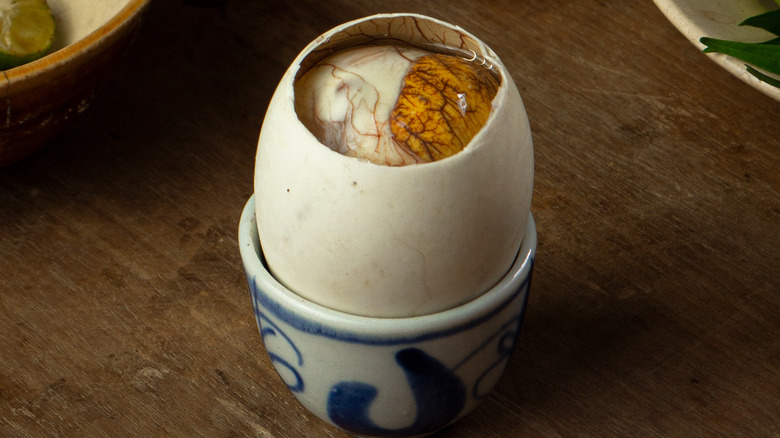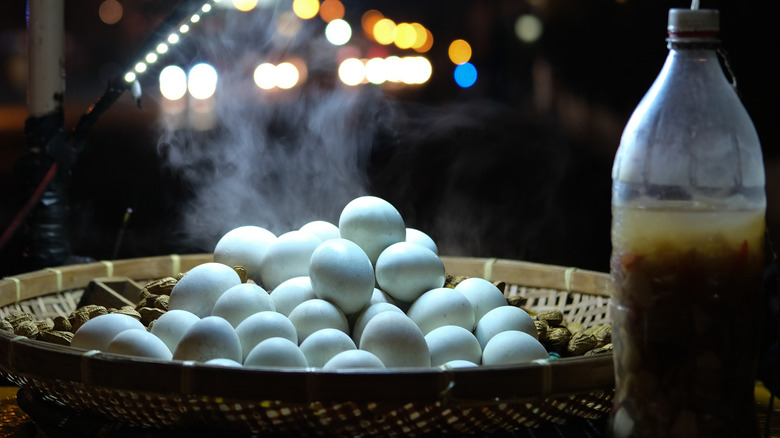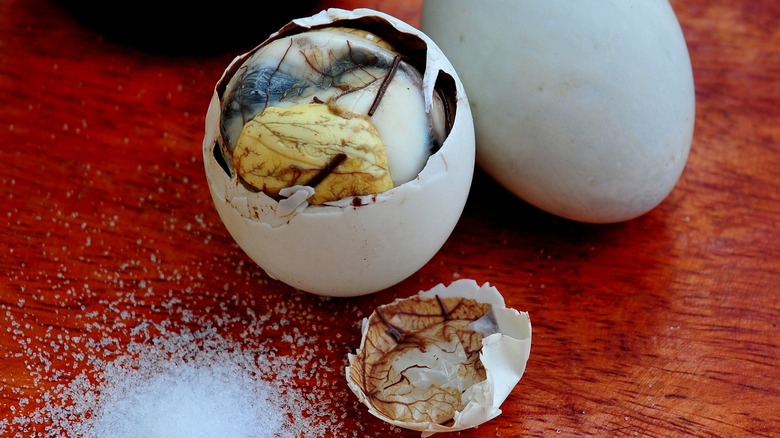Balut: The Fascinating History Behind Filipino Fertilized Duck Eggs
Most people's introduction to balut, or fertilized duck egg, is probably similar to how the reality TV show "Fear Factor" presented it to contestants in a 2002 episode: as a culinary oddity that's hard to eat, let alone stomach. It doesn't help that it's frequently cited in lists that name the "weirdest" and most exotic foods from around the world. This reinforces the idea that the practice of cracking open a fertilized egg to reveal the tiny embryo inside and slurping it all in, including the broth, is borderline uncivilized.
However, a deeper look into this Filipino street food's history reveals its deep roots in local culture. To be clear, the practice of eating boiled fertilized duck eggs isn't limited to the Philippines. With duck farming being a huge industry in Asia, contributing 82.6% of all duck meat produced globally according to a 2015 study published in the Journal of the World's Poultry Research, other countries have their own versions of balut: Vietnam has hôt vit lôn while Cambodia calls theirs phog tea khon.
The difference lies in the number of days the egg is left to incubate. With balut, the ideal length is only 17 to 18 days, when the embryo is not yet fully developed and is still encased in a white covering. Its local moniker is "balut sa puti," which means "wrapped in white." Cambodians, on the other hand, prefer their fertilized duck eggs to be 18 to 20 days old while the Vietnamese like theirs 19 to 21 days old. And, in case you're wondering, given a choice between duck eggs and chicken eggs, duck eggs are preferred because of their thicker, smoother shells.
Balut's journey from a preservation method to a food and aphrodisiac
According to a 2019 study published in the Journal of Ethnic Foods, scholars believe that traders brought the Chinese-developed practice of preserving eggs through incubation to the Philippines during the 16th century. Since then, duck farming and duck egg incubation have given rise to thriving centers throughout the archipelago. However, it's the small municipality of Pateros, located in Metro Manila, that's recognized as the capital of the country's balut industry. By the 1950s, it was raising as many as around 400,000 ducks, with the hardy itik, or Philippine mallard duck, used for producing balut.
Matching the supply was the local demand: Food scarcity during World War II had raised balut's appeal among Filipinos as a cheap and accessible food item, and Pateros became known for producing the highest-quality duck eggs. However, urbanization and the pollution of the two rivers surrounding the area led to the beginning of the local duck-raising industry's decline in the '70s. Balut-makers have since had to source eggs from nearby provinces.
It's unclear how balut gained a reputation as an aphrodisiac among Filipinos. A possible explanation is that since it's warm and packed with protein and calcium, it can boost male virility. (No mention of women's fertility, though.) Workers on graveyard shifts also rely on it for energy and nutrition. It's a popular accompaniment to beer, too, during street drinking sessions — especially at night, with the alcohol and the evening darkness said to help the balut's contents look more appetizing.
How is balut made and eaten?
Pateros balut makers' traditional preparation method is believed to yield the best balut in the world. According to a 2019 study published in the Journal of Ethnic Foods, it starts with choosing thick-shelled eggs that aren't five days old yet. They're placed under the sun for two to seven hours before getting stored in a makeshift incubator that's made of bamboo and nipa palm and constantly kept dark and humid. The eggs are carefully wrapped in a local woven fabric and then nestled inside bamboo baskets, with the youngest ones placed at the bottom.
The baskets are kept warm by surrounding sacks of mud mixed with rice husks. About thrice a day, the eggs are rotated for even heating. On the 17th day, balut makers check them by placing them in a candling device that works like an X-ray machine to look for a dark spot in the center and a network of veins. Those that pass inspection are boiled in water with salt for around 30 minutes. They're then ready to be sold at the market, in street stalls, or by ambulant vendors.
Balut is eaten straight from the shell. Simply crack the top of the wider end, sprinkle some salt or vinegar into the hole, and sip the soup; it'll taste like unseasoned chicken broth. Crack the hole wider to slurp the yolk and the embryo together, savoring the unusual textures of the embryo. Push beyond balut's "strange" reputation and give yourself a chance to try something that's integral to Filipino cuisine and culture.


